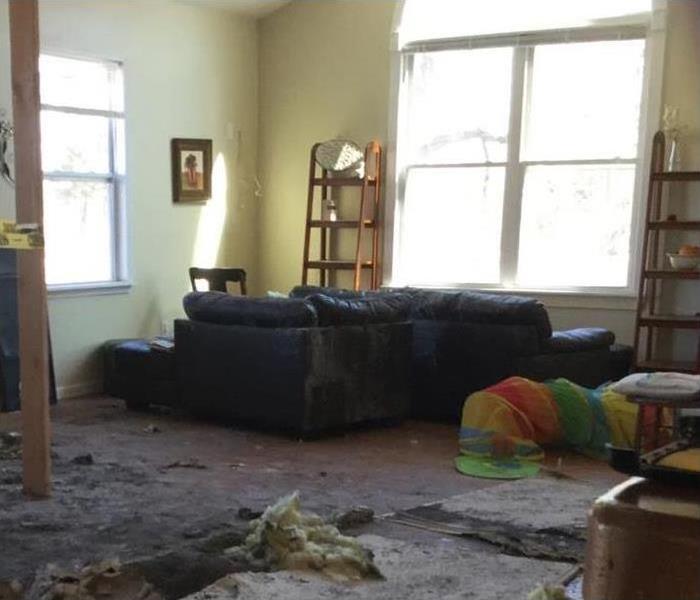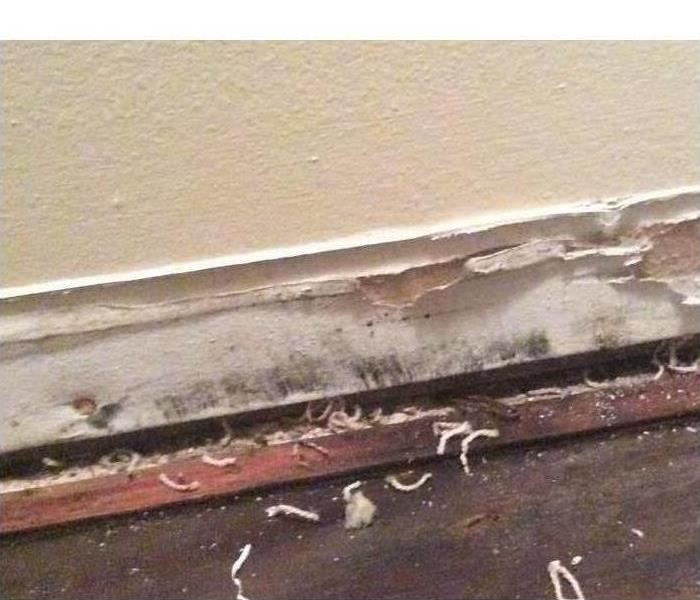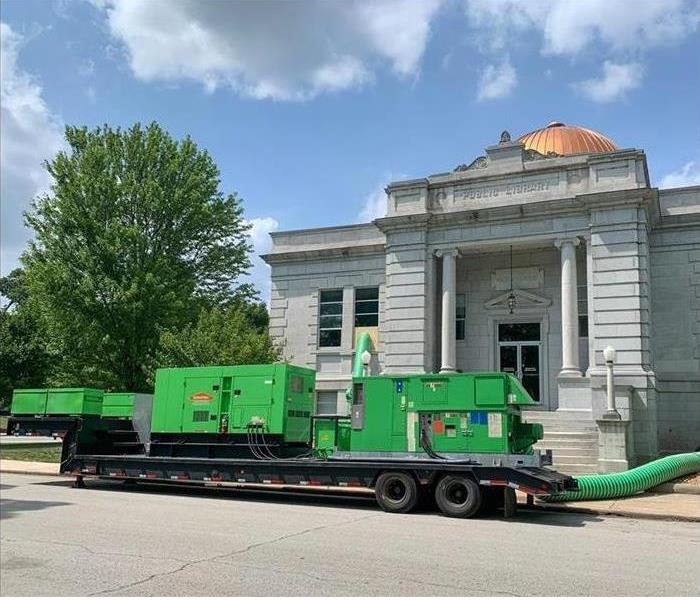Recent Commercial Posts
Who Pays For the Damage In a Rental Property After a Fire?
10/10/2022 (Permalink)
 A home fire can leave people with a feeling of all is lost.
A home fire can leave people with a feeling of all is lost.
Who Is Responsible for Repairs After a Fire in a Rental Property?
If you're renting a home or apartment in Carthage, MO, that catches on fire, you might wonder who's responsible for the cost of repairs. The answer is complicated and depends on whether you're covered by insurance or not.
Tenants need renters insurance.
If you rent a space in a multi-unit building, then chances are you live in an area where renters insurance is not required. However, as we've discussed above, tenants are still responsible for any damage they cause to the property itself and its contents during their time in the apartment. Investing in renters insurance is crucial in order to protect yourself and your belongings.
In this case, it's important for tenants to be aware that they need renters insurance—and even more so for those who plan on renting out their homes or apartments. If a tenant does not have renters insurance and causes damage to another person's home or property, that person may sue them for damages suffered resulting from the accident (or series of accidents). In addition, if there is no coverage available from other sources such as homeowners' policies or other personal policies like auto liability insurance then this could lead to financial catastrophe for both parties involved!
Landlords need to pay for building damage.
This is why when there's a fire in a rental property, the landlord is responsible for paying for building damage. This includes replacing walls, ceiling tiles, and flooring.
The tenant is responsible for content damage—anything that's not part of the structure of the building itself. That includes kitchen appliances, furniture, and other belongings you'd find inside your apartment or house.
Landlords should inform tenants about who covers what before signing any contracts, so everyone knows where they stand from day one! And remember to save receipts! In order to get reimbursed later on down the road you'll want proof that everything was replaced by someone else other than yourself.
Documentation is important
As mentioned previously, tenants should always have renters insurance, and document everything. If you don't have renter's insurance, you may be responsible for paying for repairs after a fire or other damage. Fortunately, many of the costs associated with those repairs can be covered by renter's insurance. A typical renter's policy will cover losses due to fire and lightning (including power surges), windstorm or hail, explosion, smoke damage, and water damage. Most policies also offer additional coverage for personal property like computers and furniture up to $2,000 in value—and this is usually limited only if there was loss due to theft or vandalism.
Even though landlords are responsible for the property, they can't be held responsible for everything that happens on it. It's important to have as many protections in place as possible so you're prepared when something unexpected happens. If your home or business in Carthage, MO, suffers from a fire, don’t hesitate and give our SERVPRO of Carthage/Joplin team a call for all your fire damage cleanup and restoration needs!
3 Places Mold Can Hide in Your Commercial Building
7/19/2022 (Permalink)
Places Where Mold Can Hide
Mold can damage your Sarcoxie, MO, commercial building and cause long-term issues, including an unpleasant mold smell. This odor can make your employees and customers uncomfortable, and in some cases, the mold itself may not be visible. There are several places fungi can hide, and calling in a professional mitigation and removal team can help you pinpoint the source of the odor.
1. HVAC Ducts
If your heating, ventilation and air conditioning ducts have leaks or do not operate correctly due to age, this can cause moisture to enter the ductwork, where mold can take hold and grow unchecked. Most types of fungi do not require sunlight to grow and spread, and as the mold eats, it releases a waste product called mycotoxins, which creates the fungus smell. Having your ductwork checked can uncover the source of the odor.
2. Under Carpet Padding
Even a minor flood can cause mold to grow, and if your building experienced a flood, incomplete cleanup may cause mold to grow under carpeting and beneath the padding. Dining room carpeting in a restaurant or in an office may be hiding mold, which can cause a musty mildew smell that is both persistent and unpleasant. Your mitigation technicians may have to remove the carpeting and padding to resolve the issue.
3. Behind Wallpaper
If you own a building with wallpaper, fungi may be lurking behind it and causing a mold smell you cannot pinpoint by sight. Your technicians may use thermal imaging equipment, such as cameras, to find sources of moisture and mold growth. Depending on the severity of the damage, you may have to replace the wallpaper in the affected areas.
An unpleasant mold smell inside your Sarcoxie, MO, commercial building can make your employees and customers uncomfortable. Because fungi can hide in a variety of places, calling in a professional removal team can ensure that the mold and its accompanying odor are completely eradicated.
How To Stay Safe and Minimize Loss During a Flood
7/4/2022 (Permalink)
Stay Safe During a Flood
Flood damage is something that many business owners have experienced. You can follow a few steps when faced with a flood to stay safe and minimize the amount of loss you experience.
What To Do Ahead of Time
There are steps that you can take before flooding occurs to protect yourself and your business. The most effective way to get proper protection is to purchase a flood insurance policy. Here are some other things you can do to protect your business:
- Find a storm restoration company
- Know your risk of floods
- Create an inventory of all your items
- Store important documents somewhere safe
Steps To Minimize Your Loss
Aside from these crucial things, there are several steps you can take to minimize your property damage from flooding. For instance, you can elevate and anchor all of your critical utilities, such as electrical panels, propane tanks, sockets, wiring, appliances, and HVAC systems. Another permanent thing you can do is waterproof the basement level of your building and install a sump pump. These pumps can greatly reduce the amount of damage to your building.
You may also need to do some things when rising water levels are predicted, such as clearing out your gutters. When you do this, it may also be wise to put your furniture and valuable equipment in a higher location.
Don’t Forget About Physical Safety
When flooding is imminent in Duquesne, MO, you must put yourself and your employees' safety first. You can do this by staying up to date with the local weather reports and news releases. You can also create an evacuation plan that shows your employees how to get to safety if necessary.
Floods and storm damage is something is a common threat to business owners. To protect yourself, your employees, and your business, you need to know how to prepare for the situation and minimize your loss.
Take These Steps When Your Toilet Floods
6/17/2022 (Permalink)
When Your Toilet Floods, Follow These Steps
One of the main reasons for sewer damage in Granby, MO, commercial properties is the flooded toilet. Unfortunately, there are quite a few possible causes of an overflowing toilet:
- Inappropriate items or too much of something is flushed and clogs the pipes.
- The valve, float bobber, or other components in the tank are damaged or malfunctioning.
- The seal around the fill valve has become loose.
- There may be a clog (or clogs) along the sewer line.
The resulting damage can be pretty bad, no matter where the overflowing toilet is located, but when that toilet is on the second or third floor of a building, there may be damage on multiple levels.
Contact Professionals
The first step you should take is to contact a plumbing professional or the local sewage company because the damage will continue to occur until the main cause of the problem has been corrected. This is especially important if there's a clog deep within the sewer system or if your building has an older plumbing system that could suffer further damage during repairs.
Remove Water
Next, clean up as much water as you can. The longer that water is left to sit around the toilet, the further it will seep into building materials. After mopping up as much water as you can, open windows, add fans and take other steps to further dry the area. Remember that it doesn't take long for wet building materials to create an environment where mold spreads quickly.
Schedule Restoration Services
As soon as possible, get water damage cleanup and restoration professionals to assess the damage and determine the best method of restoring your property. Restoration technicians may locate areas between the floors of the building that need attention, so you can avoid more expensive repairs down the road. These technicians will also take care of immediate needs, such as disinfecting any areas that were exposed to bacteria and waste carried in by sewer water.
Your commercial property requires high-quality results following sewer damage. Contact professionals, such as plumbers, sewage company representatives, and restoration experts right away.
Preventing Mold From Growing in Your Facility
5/14/2022 (Permalink)
 Mold can grow quickly after water damage.
Mold can grow quickly after water damage.
Mold spores exist in almost every environment, even in conditions not suitable for mold growth. However, once they find a source of moisture, it doesn't take long for them to take root in your Seneca, MO, facility. Rather than dealing with it after the fact, it's best to learn about mold prevention.
How Does Mold Grow?
Mold growth happens with just a few conditions:
- Food (surfaces containing cellulose, like wood or ceiling tile)
- A temperature between about 40 and 100 degrees Fahrenheit
- Oxygen
- Moisture
If the first three conditions are present in your facility, it's easy to see that spores can find a suitable environment once moisture is introduced.
Common Sources of Moisture in Buildings
Mold prevention means finding the most common sources of moisture in your facility.
You may find water in your HVAC system drain pans. Drains can become corroded or plugged with dirt, causing them to overflow into ducts and surrounding areas.
Ceiling tiles are porous and can absorb moisture from a roof leak. Tiles are usually made of cellulose-containing materials that feed mold. Moisture can collect in tiles around vents and pipes, areas susceptible to dirt and water leaks.
Like ceiling tiles, carpet and drywall are porous surfaces that absorb moisture. If you have water damage, a commercial building restoration service can help you dry and replace materials as needed.
Paper left in humid or damp places can provide a food source for mold. Take care to store paper reams or files in places with low humidity. Avoid storing boxes of paper on a basement or concrete floors. Moisture can travel through masonry and leave behind mold on its surface.
Watch for mold on electrical equipment, cable and fixtures. Warm, moist air can travel through gaps around outlets on exterior walls and ceiling-mounted light fixtures. If an electrical conduit has been flooded, moisture can remain inside.
Keeping an eye on areas in your building that are susceptible to moisture is the key to mold prevention. A little maintenance can prevent damage in the long run.
Storm Preparation Tips
2/24/2022 (Permalink)
 Recently, this library suffered a flood, we were able to restore the property to pre-damage conditions and get the library back open quickly. Call us!
Recently, this library suffered a flood, we were able to restore the property to pre-damage conditions and get the library back open quickly. Call us!
Prepare For A Storm
When your business is in danger from rising flood water in Carthage, MO, you can’t afford to risk your investment to water damage and a flooded building. There are many ways you can prepare your commercial property for an oncoming storm and minimize damage as much as possible.
1. Have a Plan
Your number one priority should be a disaster response and recovery plan. This plan should have clear steps outlined to define what to do in the event of an emergency, allowing you to respond as quickly as possible as soon as you learn of an impending threat. This plan should include how to protect your building’s structural integrity, how to safeguard your inventory and equipment, and the first steps to initiate immediate recovery.
2. Protect Your Investment
Be ready to minimize damage with weatherproofing. This can include sandbagging the exterior of your building, installing weather stripping, moving your equipment and inventory to higher ground, and sealing any leaks. Minimize as much damage as possible by preventing flood water from encroaching on the building.
3. Make Backups
One of the most important things you can do is back up your data. Whether you have cloud data backups or offsite disaster recovery, ensure that the most current images of your entire data repository are sufficiently backed up before the flood arrives.
4. Know Your Evacuation Routes
When the flood comes, your first instinct may be to stay as long as possible to ensure your building is appropriately protected. Instead, you should be focusing on safety, including knowing your evacuation routes. Lost inventory, equipment, and data can be recovered. Restoration professionals can repair your building. Your safety should be the utmost priority.
Include timely evacuation in your flood planning, and always have alternative evacuation routes. Be prepared to support customers in finding evacuation routes as well should any flood water rise too rapidly for them to leave the building in an appropriate amount of time.




 24/7 Emergency Service
24/7 Emergency Service


